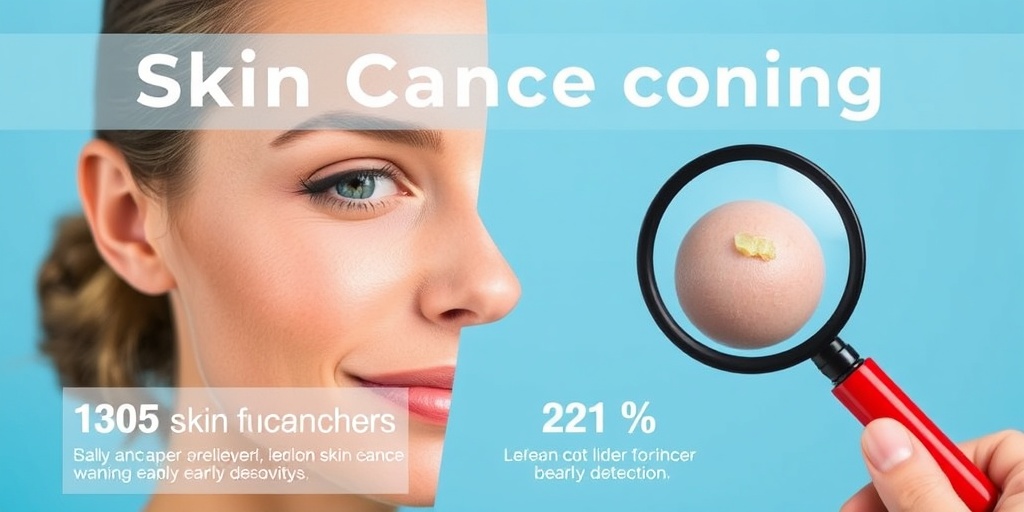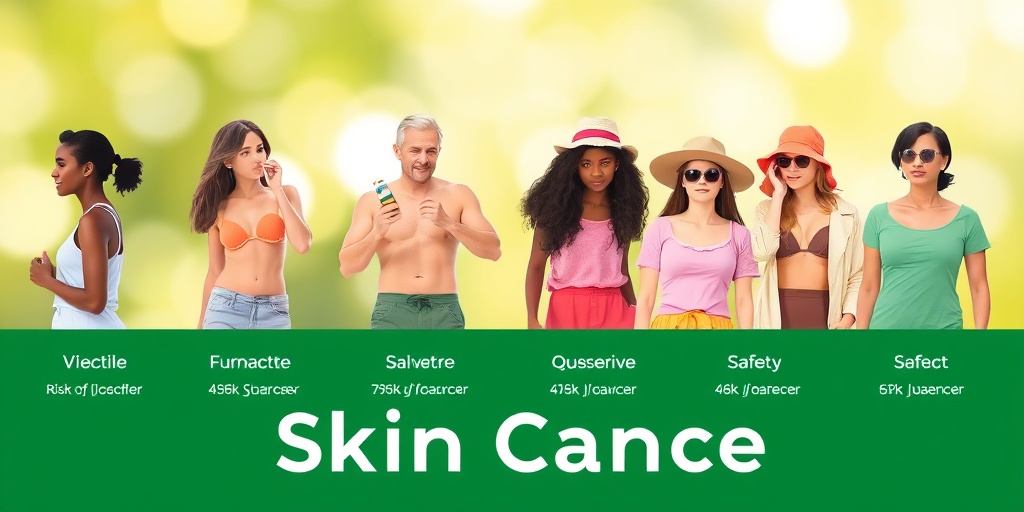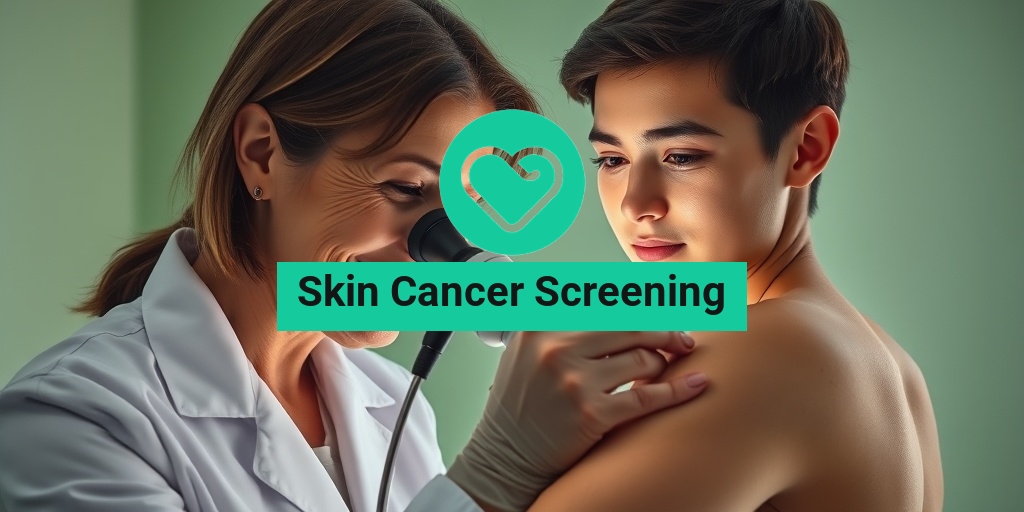What Is Skin Cancer Screening?
Skin cancer screening is a proactive health measure aimed at detecting skin cancer in its early stages. This process typically involves a thorough examination of the skin by a qualified healthcare professional, who looks for any unusual moles, growths, or changes in the skin’s appearance. The primary goal of skin cancer screening is to identify potential skin cancers before they develop into more serious conditions.
Types of Skin Cancer
There are three main types of skin cancer that screening can help detect:
- Basal Cell Carcinoma (BCC): The most common form of skin cancer, BCC usually appears as a small, shiny bump or a sore that doesn’t heal.
- Squamous Cell Carcinoma (SCC): This type often manifests as a firm, red nodule or a flat lesion with a scaly crust.
- Melanoma: The most aggressive form of skin cancer, melanoma can develop from existing moles or appear as new, unusual growths. It often has an irregular shape and varied colors.
Who Should Get Screened?
Skin cancer screening is recommended for everyone, but certain individuals may be at a higher risk and should consider more frequent screenings. These include:
- Individuals with a family history of skin cancer
- People with fair skin, light hair, and light eyes
- Those who have had excessive sun exposure or tanning bed use
- Individuals with numerous moles or atypical moles
Why Is Screening Important?
Understanding the importance of skin cancer screening can be a game-changer in the fight against skin cancer. Early detection is crucial, as it significantly increases the chances of successful treatment and recovery.
Early Detection Saves Lives
One of the most compelling reasons to undergo regular skin cancer screening is that early detection can save lives. When skin cancer is caught in its initial stages, treatment options are often less invasive and more effective. For instance, melanoma has a high survival rate when detected early, but this rate drops significantly if the cancer spreads.
Understanding Your Skin
Regular screenings help you become more familiar with your skin and its changes. By knowing what is normal for your skin, you can more easily identify any new or changing spots that may require further evaluation. This self-awareness is a vital part of skin health.
Guidelines for Screening
According to the American Academy of Dermatology, adults should perform self-exams monthly and have a professional skin exam at least once a year, especially if they are at higher risk. These guidelines help ensure that any potential issues are addressed promptly.
Cost and Accessibility
The cost of skin cancer screening can vary based on location and healthcare provider. Many insurance plans cover annual skin exams, making it more accessible for individuals. If you’re looking for a screening location, searching for “skin cancer screening near me” can yield local options. Additionally, resources like Yesil Health AI (yesilhealth.com) can provide valuable information on finding affordable screening options.
Conclusion
In conclusion, skin cancer screening is a vital component of maintaining skin health and preventing serious health issues. By understanding what skin cancer screening entails and recognizing its importance, you can take proactive steps toward safeguarding your health. Remember, early detection is key, so don’t hesitate to schedule your screening today! 🌞

Types of Skin Cancer
Skin cancer is one of the most common types of cancer, and understanding its various forms is crucial for effective skin cancer screening. There are three primary types of skin cancer, each with distinct characteristics and treatment options. Let’s explore these types in detail.
1. Basal Cell Carcinoma (BCC)
Basal cell carcinoma is the most prevalent form of skin cancer, accounting for about 80% of all skin cancer cases. It typically arises in areas of the skin that are frequently exposed to the sun, such as the face, neck, and ears.
- Appearance: BCC often appears as a small, shiny bump or a pinkish patch. It may also present as a sore that doesn’t heal.
- Growth Rate: This type of cancer grows slowly and rarely spreads to other parts of the body.
- Treatment: Treatment options include surgical removal, topical medications, and in some cases, radiation therapy.
2. Squamous Cell Carcinoma (SCC)
Squamous cell carcinoma is the second most common type of skin cancer, representing about 16% of cases. It usually develops on sun-exposed areas but can also occur in other regions of the body.
- Appearance: SCC may appear as a firm, red nodule or a flat sore with a scaly crust.
- Growth Rate: This type can grow more quickly than BCC and has a higher risk of spreading if not treated promptly.
- Treatment: Treatment typically involves surgical excision, cryotherapy, or topical chemotherapy.
3. Melanoma
Melanoma is the most aggressive form of skin cancer, though it accounts for only about 4% of cases. It originates in the melanocytes, the cells responsible for producing melanin, the pigment that gives skin its color.
- Appearance: Melanoma can develop from existing moles or appear as new, unusual-looking moles. The ABCDE rule (Asymmetry, Border, Color, Diameter, Evolving) is a helpful guideline for identifying potential melanomas.
- Growth Rate: Melanoma can grow rapidly and has a high potential to spread to other organs if not detected early.
- Treatment: Treatment often involves surgical removal, immunotherapy, targeted therapy, and chemotherapy.
Risk Factors for Skin Cancer
Understanding the risk factors associated with skin cancer is essential for effective skin cancer screening and prevention. While anyone can develop skin cancer, certain factors can increase your risk. Here are some of the most significant risk factors:
1. Ultraviolet (UV) Radiation Exposure
One of the leading causes of skin cancer is exposure to UV radiation from the sun or tanning beds. Prolonged and unprotected exposure can damage the skin’s DNA, leading to cancerous changes.
2. Skin Type
Individuals with fair skin, light hair, and light-colored eyes are at a higher risk of developing skin cancer. This is because they have less melanin, which provides some protection against UV radiation.
3. Family History
A family history of skin cancer can significantly increase your risk. If your parents or siblings have had skin cancer, it’s essential to discuss this with your healthcare provider and consider regular screenings.
4. Age
As we age, our skin undergoes changes that can increase the risk of skin cancer. Most cases are diagnosed in individuals over the age of 50, but younger people can also be affected.
5. Weakened Immune System
People with weakened immune systems, such as those undergoing chemotherapy or living with HIV/AIDS, are at a higher risk for skin cancer. Regular screenings are crucial for early detection in these individuals.
6. Previous Skin Cancer Diagnosis
If you have had skin cancer in the past, your risk of developing it again increases. Regular follow-ups and screenings are vital for monitoring any changes in your skin.
By being aware of these risk factors and understanding the types of skin cancer, you can take proactive steps in your skin cancer screening journey. Regular check-ups with a dermatologist and self-examinations can help catch any abnormalities early, leading to better outcomes. 🌞

Screening Methods Explained
Skin cancer screening is a crucial step in early detection and prevention of skin cancer. There are several methods used to screen for skin cancer, each with its own advantages and considerations. Understanding these methods can help you make informed decisions about your skin health.
Visual Examination
The most common method of skin cancer screening is a visual examination performed by a healthcare professional. During this examination, the doctor will inspect your skin for any unusual moles, growths, or changes in existing skin lesions. They will look for the ABCDEs of melanoma:
- Asymmetry: One half of the mole doesn’t match the other.
- Border: Irregular, scalloped, or poorly defined edges.
- Color: Varied colors (brown, black, tan, red, white, or blue).
- Diameter: Larger than 6mm (about the size of a pencil eraser).
- Evolving: Changes in size, shape, or color over time.
Regular visual examinations are recommended, especially for individuals with a higher risk of skin cancer, such as those with a family history or fair skin. 🩺
Dermatoscopy
Another effective method is dermatoscopy, which involves using a handheld device called a dermatoscope. This tool allows dermatologists to examine the skin in greater detail, magnifying the surface and providing a clearer view of the structures within moles and lesions. This method can help differentiate between benign and malignant growths more accurately.
Skin Biopsy
If a suspicious area is identified during a visual examination or dermatoscopy, a skin biopsy may be performed. This procedure involves removing a small sample of skin tissue for laboratory analysis. There are different types of biopsies, including:
- Shave biopsy: A thin layer of skin is shaved off.
- Excisional biopsy: The entire mole or lesion is removed.
- Punch biopsy: A circular tool is used to remove a deeper section of skin.
Biopsies are essential for confirming a diagnosis of skin cancer and determining the appropriate treatment plan. 🧪
Self-Examination
In addition to professional screenings, self-examination is an important practice. Regularly checking your skin for any changes can help you catch potential issues early. Here are some tips for effective self-examination:
- Use a full-length mirror and a hand mirror to check all areas of your body.
- Look for new moles or changes in existing moles.
- Pay attention to areas that are often exposed to the sun, such as your face, neck, and arms.
By being proactive and aware of your skin, you can play a vital role in your skin health. 🌞
What to Expect During a Screening
Preparing for a skin cancer screening can help ease any anxiety you may have. Here’s what you can expect during your appointment:
Before the Screening
Before your screening, it’s important to inform your healthcare provider about:
- Your medical history, including any previous skin cancers.
- Any medications you are currently taking.
- Family history of skin cancer.
These details will help your doctor assess your risk and tailor the screening to your needs. 📝
During the Screening
During the actual screening, you will typically:
- Change into a gown to allow for a thorough examination of your skin.
- Be asked to lie down while the doctor examines your skin from head to toe.
- Have any suspicious areas marked for further evaluation.
The entire process usually takes about 15 to 30 minutes, depending on the extent of the examination. It’s a quick and painless procedure, and your doctor will explain each step along the way. 😊
After the Screening
After the screening, your doctor will discuss their findings with you. If any biopsies were taken, you will receive instructions on how to care for the biopsy site and when to expect results. If no issues are found, your doctor may recommend a follow-up screening in six months to a year, depending on your risk factors.
Remember, early detection is key in the fight against skin cancer. Regular screenings can save lives! 🌟

Skin Cancer Symptoms to Watch For
Skin cancer is one of the most common types of cancer, and early detection is crucial for effective treatment. Being aware of the symptoms can help you catch it early. Here are some key signs to look out for:
Changes in Moles
One of the most significant indicators of skin cancer is changes in existing moles. Keep an eye out for:
- Asymmetry: If one half of the mole doesn’t match the other.
- Borders: Irregular, scalloped, or poorly defined edges.
- Color: A variety of colors within the mole, including shades of brown, black, or even red, white, or blue.
- Diameter: Moles larger than 6mm (about the size of a pencil eraser) should be examined.
- Evolving: Any change in size, shape, or color over time.
New Growths on the Skin
New spots or growths on your skin can also be a warning sign. Look for:
- Small, shiny, or pearly bumps: These may indicate basal cell carcinoma.
- Red, scaly patches: These can be a sign of squamous cell carcinoma.
- Dark, irregularly shaped spots: These may be melanoma, the most dangerous form of skin cancer.
Itching, Tenderness, or Pain
If you notice any areas of your skin that are itchy, tender, or painful, it’s essential to consult a healthcare professional. These symptoms can be associated with skin cancer, especially if they persist over time.
Non-Healing Sores
Another critical symptom to watch for is sores that do not heal. If you have a sore that lasts for more than a few weeks, it’s time to seek medical advice. This could be a sign of skin cancer or another serious condition.
Skin Changes in Unusual Areas
Skin cancer can develop in areas that are not typically exposed to the sun, such as the palms of your hands, under your nails, or on the soles of your feet. Be vigilant about checking these areas as well.
Follow-Up Care After Screening
After undergoing a skin cancer screening, it’s essential to understand the next steps in your care. Follow-up care can vary based on the results of your screening, but here are some general guidelines:
Understanding Your Results
Once your screening is complete, your healthcare provider will discuss the results with you. If any suspicious areas were identified, further testing may be necessary. This could include:
- Biopsy: A small sample of skin may be taken for laboratory analysis.
- Imaging tests: In some cases, imaging may be required to determine if cancer has spread.
Regular Skin Checks
Regardless of your screening results, it’s vital to continue performing regular self-examinations of your skin. Familiarize yourself with your skin’s normal appearance so you can quickly identify any changes. Schedule follow-up appointments with your dermatologist as recommended.
Sun Protection Strategies
After a skin cancer screening, adopting sun protection strategies is crucial. Here are some tips:
- Use sunscreen: Apply a broad-spectrum sunscreen with an SPF of at least 30 daily.
- Wear protective clothing: Long sleeves, hats, and sunglasses can help shield your skin from harmful UV rays.
- Avoid tanning beds: These can significantly increase your risk of developing skin cancer.
Healthy Lifestyle Choices
Maintaining a healthy lifestyle can also play a role in skin health. Consider incorporating:
- A balanced diet: Foods rich in antioxidants can help protect your skin.
- Regular exercise: Staying active can improve your overall health and well-being.
- Avoiding smoking: Smoking can increase your risk of skin cancer and other health issues.
By being proactive about your skin health and following up after screenings, you can significantly reduce your risk of skin cancer and ensure early detection if it does occur. Remember, your skin is your body’s largest organ, and taking care of it is essential! 🌞

Frequently Asked Questions about Skin Cancer Screening
What is Skin Cancer Screening?
Skin cancer screening is a preventive measure that involves examining the skin for signs of cancerous or precancerous lesions. This process can help detect skin cancer early when it is most treatable.
Why is Skin Cancer Screening Important?
Early detection of skin cancer significantly increases the chances of successful treatment. Regular screenings can identify changes in the skin that may indicate cancer, allowing for timely intervention.
Who Should Get Screened for Skin Cancer?
Individuals at higher risk, such as those with a family history of skin cancer, fair skin, or a history of excessive sun exposure, should consider regular skin cancer screening. However, anyone can benefit from periodic checks.
What Does the Skin Cancer Screening Procedure Involve?
The skin cancer screening procedure typically involves a visual examination of the skin by a healthcare professional. They will look for unusual moles or skin changes and may perform a biopsy if necessary.
How Often Should I Get a Skin Cancer Screening?
The frequency of screenings can vary based on individual risk factors. Generally, it is recommended to have a screening at least once a year, but those at higher risk may need more frequent evaluations.
What Are the Costs Associated with Skin Cancer Screening?
The skin cancer screening cost can vary depending on the provider and location. Many insurance plans cover screenings, but it’s advisable to check with your insurance provider for specific details.
Are There Guidelines for Skin Cancer Screening?
Yes, there are established skin cancer screening guidelines that recommend regular examinations based on age, skin type, and risk factors. Consult with your healthcare provider to determine the best schedule for you.
What is the ICD-10 Code for Skin Cancer Screening?
The ICD-10 code for skin cancer screening is Z12.83. This code is used for billing and insurance purposes to indicate that a patient is being screened for skin cancer.
Where Can I Find Skin Cancer Screening Near Me?
To find skin cancer screening near me, you can search online for local dermatologists or clinics that offer skin cancer screenings. Many hospitals also provide these services.
What Should I Expect After a Skin Cancer Screening?
After a skin cancer screening, your healthcare provider will discuss any findings with you. If any suspicious areas are identified, they may recommend further testing or a biopsy.
Can Skin Cancer Screening Be Done at Home?
While self-examinations can help you monitor your skin, professional screenings are essential for accurate diagnosis. It’s important to consult a healthcare provider for a thorough examination.
How Can I Prepare for My Skin Cancer Screening?
- Wear loose clothing to allow easy access to your skin.
- Bring a list of any skin changes or concerns you have noticed.
- Be prepared to discuss your medical history and any risk factors.
Regular skin cancer screening is a vital part of maintaining skin health. If you have further questions or concerns, don’t hesitate to reach out to a healthcare professional! 🌞




